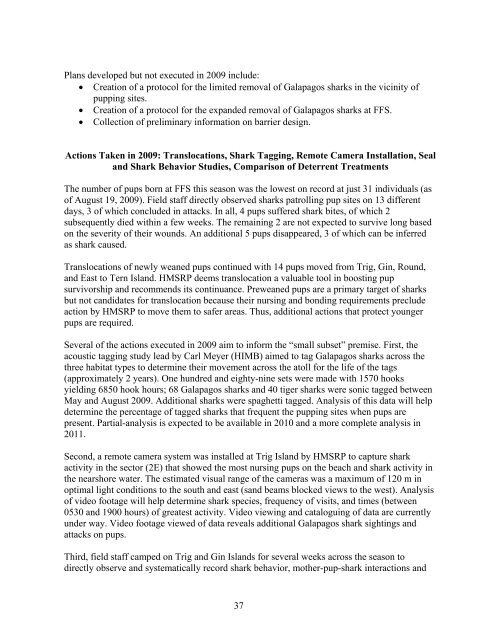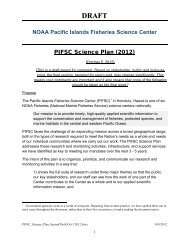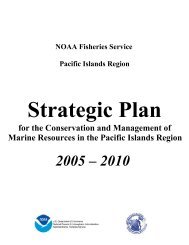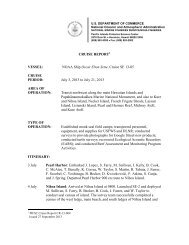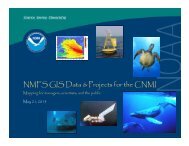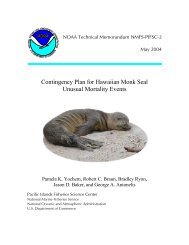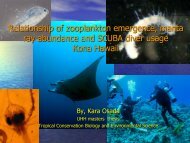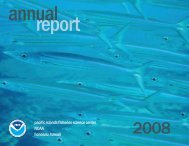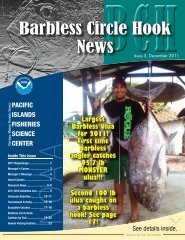Shark Predation on Hawaiian Monk Seals - Pacific Islands Fisheries ...
Shark Predation on Hawaiian Monk Seals - Pacific Islands Fisheries ...
Shark Predation on Hawaiian Monk Seals - Pacific Islands Fisheries ...
You also want an ePaper? Increase the reach of your titles
YUMPU automatically turns print PDFs into web optimized ePapers that Google loves.
Plans developed but not executed in 2009 include:<br />
Creati<strong>on</strong> of a protocol for the limited removal of Galapagos sharks in the vicinity of<br />
pupping sites.<br />
Creati<strong>on</strong> of a protocol for the expanded removal of Galapagos sharks at FFS.<br />
Collecti<strong>on</strong> of preliminary informati<strong>on</strong> <strong>on</strong> barrier design.<br />
Acti<strong>on</strong>s Taken in 2009: Translocati<strong>on</strong>s, <str<strong>on</strong>g>Shark</str<strong>on</strong>g> Tagging, Remote Camera Installati<strong>on</strong>, Seal<br />
and <str<strong>on</strong>g>Shark</str<strong>on</strong>g> Behavior Studies, Comparis<strong>on</strong> of Deterrent Treatments<br />
The number of pups born at FFS this seas<strong>on</strong> was the lowest <strong>on</strong> record at just 31 individuals (as<br />
of August 19, 2009). Field staff directly observed sharks patrolling pup sites <strong>on</strong> 13 different<br />
days, 3 of which c<strong>on</strong>cluded in attacks. In all, 4 pups suffered shark bites, of which 2<br />
subsequently died within a few weeks. The remaining 2 are not expected to survive l<strong>on</strong>g based<br />
<strong>on</strong> the severity of their wounds. An additi<strong>on</strong>al 5 pups disappeared, 3 of which can be inferred<br />
as shark caused.<br />
Translocati<strong>on</strong>s of newly weaned pups c<strong>on</strong>tinued with 14 pups moved from Trig, Gin, Round,<br />
and East to Tern Island. HMSRP deems translocati<strong>on</strong> a valuable tool in boosting pup<br />
survivorship and recommends its c<strong>on</strong>tinuance. Preweaned pups are a primary target of sharks<br />
but not candidates for translocati<strong>on</strong> because their nursing and b<strong>on</strong>ding requirements preclude<br />
acti<strong>on</strong> by HMSRP to move them to safer areas. Thus, additi<strong>on</strong>al acti<strong>on</strong>s that protect younger<br />
pups are required.<br />
Several of the acti<strong>on</strong>s executed in 2009 aim to inform the “small subset” premise. First, the<br />
acoustic tagging study lead by Carl Meyer (HIMB) aimed to tag Galapagos sharks across the<br />
three habitat types to determine their movement across the atoll for the life of the tags<br />
(approximately 2 years). One hundred and eighty-nine sets were made with 1570 hooks<br />
yielding 6850 hook hours; 68 Galapagos sharks and 40 tiger sharks were s<strong>on</strong>ic tagged between<br />
May and August 2009. Additi<strong>on</strong>al sharks were spaghetti tagged. Analysis of this data will help<br />
determine the percentage of tagged sharks that frequent the pupping sites when pups are<br />
present. Partial-analysis is expected to be available in 2010 and a more complete analysis in<br />
2011.<br />
Sec<strong>on</strong>d, a remote camera system was installed at Trig Island by HMSRP to capture shark<br />
activity in the sector (2E) that showed the most nursing pups <strong>on</strong> the beach and shark activity in<br />
the nearshore water. The estimated visual range of the cameras was a maximum of 120 m in<br />
optimal light c<strong>on</strong>diti<strong>on</strong>s to the south and east (sand beams blocked views to the west). Analysis<br />
of video footage will help determine shark species, frequency of visits, and times (between<br />
0530 and 1900 hours) of greatest activity. Video viewing and cataloguing of data are currently<br />
under way. Video footage viewed of data reveals additi<strong>on</strong>al Galapagos shark sightings and<br />
attacks <strong>on</strong> pups.<br />
Third, field staff camped <strong>on</strong> Trig and Gin <strong>Islands</strong> for several weeks across the seas<strong>on</strong> to<br />
directly observe and systematically record shark behavior, mother-pup-shark interacti<strong>on</strong>s and<br />
37


